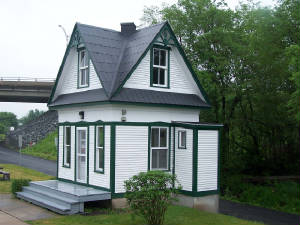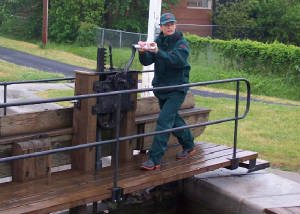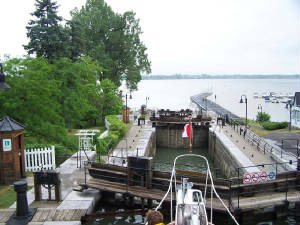Wednesday, June 15, 2005
Rouses Point, NY to Saint-Jean-Sur-Richlieu, Quebec
23.7 miles
We were up early, but couldn't leave the marina until the office opened at 9 am. We had a rest room
key to return to get our $20 deposit back, and the marina is still on off-season hours. We took advantage of the late
departure time, and went out to breakfast at a local restaurant with a great bargain breakfast and fresh home-made donuts.
The Canadian border is less than a mile north of Rouses Point, so we left the marina flying a yellow quarantine
flag. Officially, boats have to fly the flag from the time that they cross the border until they are registered with
Canadian Customs. When the flag is flying, no one can get on the boat, and no one except the captain can get off the
boat.
We called Canadian Customs about eight minutes after leaving the marina, answered lots of questions over
the phone, and then had to pull in to the Customs Wharf to show our boat papers and register.
We were back on the Richlieu River, with our Canadian courtesy flag replacing the quarantine flag,
by 10 am.
The skies were overcast, but the haze that has plagued us for nearly two weeks was gone, and we had crisp,
albeit grey, views. Gone are the mountains -- this land is flat, and its trees are deciduous. The only whiff of
pine is from the balsam fir pillow Cathy and Chappy brought us.
Little cottages and trailers on postage stamp lots line the banks of the river. We think that in the
United States waterfront property this beautiful with deep water access would be lined with million dollar mansions by
now. The view is very refreshing.
As the morning wore on, the clouds built, and we could see dark rainstorm skies to our west. A little
later, lightning was flashing in the dark skies. Then the dark skies and lightning spread to encompass the area just
a few miles ahead.
We hit the storm squall rain torrents just a half mile from the free public docks of St.-Jean. We
plowed through and missed being struck by lightning, though it was a definite possibility. Within five seconds of leaving
the flybridge to handle the lines as we docked, I was soaked to the skin everywhere my rain jacket didn't cover. It
was a relief to be stopped and tethered to land.
We stayed warm and dry inside for most of the afternoon, as the rain continued to pour down with only brief
intermissions. After about 4 pm, the sky seemed to be clearing, so we ventured out to explore the town.
St.-Jean-sur-Richlieu feels like a European city, and not just because all the signs are in French.
The canal and river lend the atmosphere of the Netherlands. There were no American chains anywhere to be seen. We
must have passed at least 25 little restaurants and cafes as we walked about town, and lots more little shops and businesses,
all with apartments upstairs. Even the residential streets have little businesses along them. A sewing factory
that must have had a couple hundred sewing machines in neat rows had big windows looking out on the sidewalk. The brass
plaque by the door had the name of the company and "corsets." It is hard to believe they are still in the corset business
today.
We were very proud of ourselves for finding a geocache which was described in French. It was our first
cache outside the US, and our first foreign language cache.
When it was time for dinner, the choices were endless -- fish and chips, Thai/Vietnamese, Sushi, wood-fired
pizzas -- just about any nationality or specialty food was available within an easy walk. We chose an Irish Pub restaurant
that specializes in casual French food. They had about 40 different main course crepe options, and a couple dozen dessert
crepes. We each had a dinner crepe, then shared a chocolate crepe with ice cream on top for dessert. Tres bon!
Thursday, June 16, 2005 Saint John-sur-Richlieu to Sorel, Quebec
57.5 miles
10 locks (8 hand-operated) with a total drop of 84 feet

|
| Historic Lock House--"Neo-Queen Ann Style" |
The highlight of today was to be our first experience in the historic hand-operated locks of
Canada. Our spirits were only slightly dampened by the rainy weather we faced for our trip through the locks.
At 8:15, we donned our foulies, as Dick now affectionately calls our full foul wather gear, and we prepared
to make our way into the first of the nine Chambly Canal Locks. The lock tender called us to enter the lock promptly
at 8:30, as scheduled, and when he had us secured, he gave us our instructions for locking through.
Then Vicky, our bridge tender for the day, introduced herself and gave us her instructions. Because
it is early in the season, the canal bridges are not fully staffed. Vicky would zip ahead of us in her car and wait
at each bridge for our approach, then stop traffic, open the bridge by hand for us, close it by hand, and race to the
next bridge.
For the system to work, we had to keep to the six miles per hour speed limit, and the boat locking through
with us, Mam Sel, had to stay close behind us to keep the bridge pass-through time to a minimum. This is why
the tenders who work this time of year refer to themselves as the "Flying Squad."

|
| Cranking the door that lets water out |
The canal was opened in 1843, with the goal of facilitating the export of Canadian lumber to the United
States. The canal is ten miles long, and bypasses the Chambly rapids of the Richlieu River. Its locks were constructed
to accomodate canal barges, which were towed by horses on the canal, and pulled by steamboats on the lakes and rivers.
The locks are quite small -- our boat and the sailboat, which was about our size, had a tight squeeze fitting
in the lock together. We had to pull to the very front of the lock, and the sailboat had to tie to the opposite wall
and hug the back of the lock.
It took us just under four hours to make our way through the canal. The tenders, all in natty spruce
green foul weather uniforms, were, without exception, friendly, polite and helpful (which is not a claim we could make universally
about the tenders of the New York State Canal System). The tenders worked in teams of two, first securing our boats
to the lock wall, then each cranking one of the wooden lock doors closed and cranking a separate mechanism to open a gate
at the bottom of each door to let water out of the lock chamber. When we reached the lower water level, they would crank the
lock doors open.

|
| The final three step locks |
The first three locks were spread apart and had different tenders, but as we got to the last six locks,
they were arranged as two sets of three locks each going down a hill like stairs. One those locks two crews leap-frogged
each other -- one crew helped us through the first lock, then took a golf cart to the third lock, while a second crew helped
us in the second lock, then drove to the fourth lock to wait for us, and so on.
Fortunately, the rain turned to a light mist by mid-morning, and stopped by the time we were going through
the long lock set. It would have been miserable standing in cold rain for over an hour straight handling lines as we
made our way down the lock steps.
We got to our final lock of the day, the St. Ours Lock, nearly four hours after we left the last of the
Chambly locks. As we cruised into the spacious lock with a convenient floating dock inside to tie up to, a woman
with a hand-held computer greeted us and recorded our lock pass number and boat data. We marveled at how our lock experiences
today spanned the centuries -- from being cranked up and down with the same mechanisms used over 160 years ago, to being
digitally tracked with a device that didn't exist even 16 years ago.
We finally reached our marina near Sorel at 5:10 pm. It took us almost nine hours to travel less than
60 miles. It felt like a very long day.
We found a lovely French restaurant in a hotel right outside the marina gates, so we didn't have to
go to much effort at all to have a perfect end to the day. For what we figured was considerably less than $25 US per
person, we each had beautifully prepared meals with an amusee, soup, appetizer salad, palate cleanser, main course and
dessert. It was a bit of a challenge to figure out what the menu choices were, and we are still not sure what exactly
some of the things we ate were, but, no question, it was a very fine meal at a steal of a price.
To continue to Quebec page 2, click here.
|

